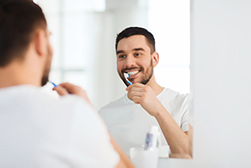When cleaning your mouth, it is advised that you not only clean your teeth but also your tongue, gums, cheeks and the roof of your mouth. This has to be done for at least 2 minutes, ideally twice per day, in order to maintain a good dental hygiene. Cleaning or brushing your entire mouth helps you get rid of excess food particles, plaque that might have built up, and bacteria that might have been collected on the cheeks or between your teeth and the surface of your tongue. Proper cleaning of all these areas helps to prevent tooth decay and gum diseases such as gingivitis.

How To Brush Your Entire Mouth
Cleaning the tongue enables you to get rid of plaque, food particles, building bacteria and dead skin that can make your tongue appear white instead of the normal pink color. When brushing the tongue, it is best to start at the back of the tongue and work your way forward in long, full strokes. If your toothbrush as a tongue scraper on the back of it, you can use this instead of the bristles. When cleaning your gums, it is advised that you set the toothbrush at an angle, mostly 45 degrees, so that you may be able to get rid of any debris that might be hidden underneath the gumline.
When cleaning the cheeks, you have to meticulously and slowly brush the inside part of your cheeks. You can also swirl a mouthful of mouthwash for a cleaner cheek. Using a mouthwash will also give you fresh breath that lasts longer. Mouthwash can also aid in loosening hidden food particles, making it easier for you to get rid of them during brushing, apart from also killing bacteria.
Cleaning or brushing the roof of your mouth commonly known as the palate also helps to get rid of bacteria that might cause conditions such as Halitosis. Brushing of the palate should be done using a soft brush to prevent excessive movement that can injure the palate.
If you have more questions or would like to schedule an appointment, contact our offices today!
